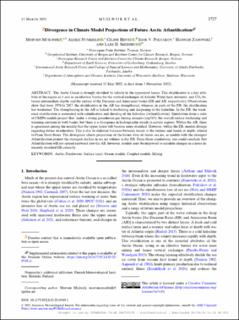| dc.description.abstract | The Arctic Ocean is strongly stratified by salinity in the uppermost layers. This stratification is a key attribute of the region as it acts as an effective barrier for the vertical exchanges of Atlantic Water heat, nutrients, and CO2 between intermediate depths and the surface of the Eurasian and Amerasian basins (EB and AB, respectively). Observations show that from 1970 to 2017, the stratification in the AB has strengthened, whereas, in parts of the EB, the stratification has weakened. The strengthening in the AB is linked to freshening and deepening of the halocline. In the EB, the weakened stratification is associated with salinification and shoaling of the halocline (Atlantification). Simulations from a suite of CMIP6 models project that, under a strong greenhouse gas forcing scenario (ssp585), the overall surface freshening and warming continue in both basins, but there is a divergence in hydrographic trends in certain regions. Within the AB, there is agreement among the models that the upper layers will become more stratified. However, within the EB, models diverge regarding future stratification. This is due to different balances between trends at the surface and trends at depth, related to Fram Strait fluxes. The divergence affects projections of the future state of Arctic sea ice, as models with the strongest Atlantification project the strongest decline in sea ice volume in the EB. From these simulations, one could conclude that Atlantification will not spread eastward into the AB; however, models must be improved to simulate changes in a more intricately stratified EB correctly. | en_US |

